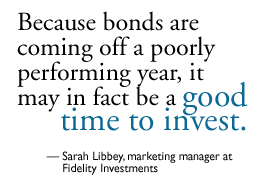|
Muni me?
|
 |
February 1, 2000: 10:06 a.m. ET
Investors seeking federal tax relief can scoop up municipal bond funds
By Staff Writer Jennifer Karchmer
|
NEW YORK (CNNfn) - You may not care if your hometown is building a new highway, but it could give you a way to protect your investment portfolio from the IRS.
Wealthy investors can ease the tax bite on their assets with tax-free municipal bond funds that provide the cash for cities and states to build bridges, new roads and other public projects.
Bond mutual funds took a beating last year as the Federal Reserve raised interest rates three times. But as rates continue to increase, prices of municipal bonds fall, making them more attractive to buy now, noted Gary Strumeyer, head of municipal bond trading at BNY Capital Markets in New York. Tax-free securities are pretty cheap compared to taxable Treasury bonds.
If you're making more than $100,000 a year, or you're in a tax bracket higher than 28%, you should be looking at municipal bond funds, he said.

How do your dollars help build a new bridge? When a municipality, such as a state, city, or school district, decides to build a bridge, road or other new project, it raises money by issuing millions of dollars in tax-free bonds. A mutual fund will pick a variety of different bond offerings representing different sectors such as health care, utilities, water and sewer projects. All of the bonds have different risk levels.
The advantage is that the income generated from municipal bond mutual funds is exempt from federal taxes. And if you invest in a mutual fund specific to the state you live in, then you are exempt from state taxes as well.
With a default rate of about one percent, municipals are probably the safest investment out there. More than half of all municipal bonds are covered by insurance offered by MBIA, Ambac, or Financial Guaranty Insurance Company.
In addition, the three main credit rating agencies, Standard & Poor's, Moody's Investors Service, and Fitch IBCA Inc., rate municipal bonds based on the strength of their balance sheets and other factors.
So for a young investor in a high tax bracket, a 30 percent allocation in municipal bonds may be suitable for a retirement portfolio, suggests financial planner Paul Levis of Summit Financial Consultants in Yonkers, N.Y.
Invest short-term for the long haul
Because no one knows exactly where interest rates are headed this year, keep an eye on portfolios that invest in bonds with shorter maturities, says Morningstar bond analyst Chris Kelsch. The shorter the duration, the less sensitive it is to interest rate fluctuations. Here are some funds to consider:
- Davis Tax-Free High Income Fund VMPIX
- Strong Short-Term Municipal Bond Fund STSMX
- T. Rowe Price Tax-Free Short Intermediate Municipal Bond Fund PRFSX
- USAA Tax-Exempt Short-Term Municipal Bond Fund USSTX
- Vanguard Limited-Term Tax-Exempt Fund VMLTX
If you've taken advantage of the tremendous bull run of the equity market, offsetting your portfolio with tax-free investments is a smart choice, analysts say.
And with tax season in full swing, you're probably thinking about how much of your income you're lopping off to Uncle Sam.
"People realize they need to do a better job of repositioning their portfolios to reduce taxes," said Sarah Libbey, senior vice president of product management and development at Fidelity Investments in Boston.
Taxable vs. tax-free?
You might think you'd earn more on a taxable bond fund than a muni bond fund by looking at the yields. But by calculating the taxable equivalent yield on the municipal bond fund, you'll realize in the end you're making more by not paying taxes.
You make the calculation by using the following formula: take your tax rate and subtract it from the number one. Then divide the yield of the muni bond fund by that number.
For example, let's say an investor in the 28 percent tax bracket owns the Vanguard Limited-Term Tax-Exempt Fund, with a 12-month yield of 4.33 percent. Subtract 28 percent from 1.00 (0.72); and divide that number into 4.33 percent. That gives you a taxable equivalent yield of 6.01 percent.
To find a taxable bond fund with a more desirable after-tax yield than the muni fund, you'd have to invest in one with a 12-month yield higher than 6.01 percent. But a comparable taxable fund these days is earning only 5.72 percent.
Bonds direct
If you decide to hold individual bonds instead of investing in a municipal bond fund, it makes sense to stick with high quality, A-rated or higher bonds of a city or state, Strumeyer recommends. Lower quality bonds specific to the health care or utility sectors are more risky, and you probably want to steer clear unless you're well versed in muni bonds.
Most investors interested in tax-free bonds, in fact, need some professional hand-holding by a broker who can walk them through the intricacies of municipal investing.
Unlike stocks, you buy and sell municipal bonds in over-the-counter
trading rather than through a centralized location such as the New York Stock
Exchange. And the bond market lags the stock market in terms of executing trades over the Internet.
Several Web sites exist that post dealer inventories of tax-free bonds. However, you must call the broker to execute the trade.
Investinginbonds.com, a Web site run by The Bond Market Association, posts municipal bond offerings, their trading prices and activity based on previous days' trades.
"I still think munis are a hard sell online," Strumeyer said. 
|
|
|
|
|
 |

|

